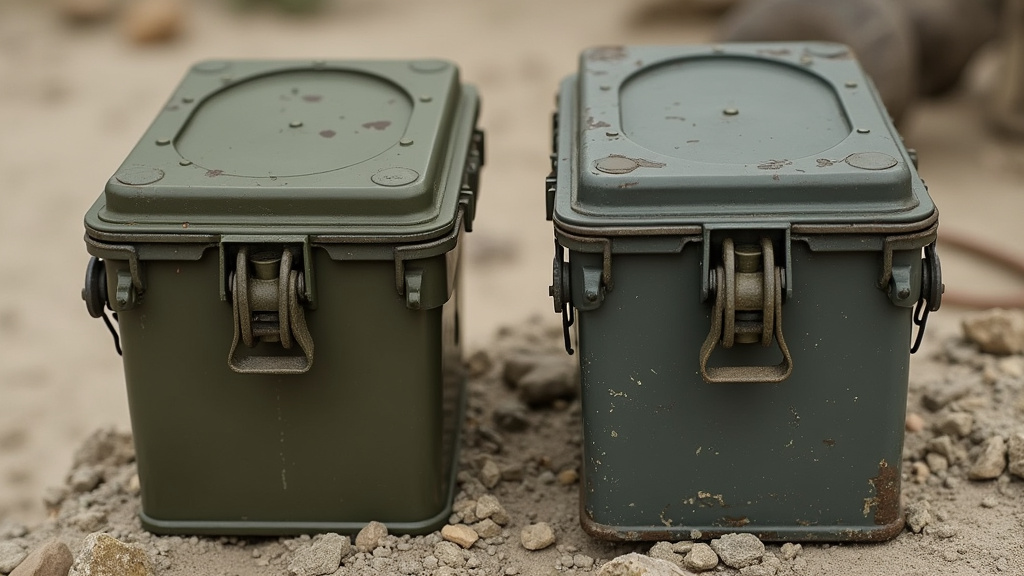When it comes to ammo storage, enthusiasts and professionals alike often face the choice between plastic and metal ammo cans. This decision impacts not only the safety and preservation of ammunition but also the ease of transport and overall durability of the storage solution.
Both plastic ammo cans and metal ammo cans have their unique advantages and drawbacks, making the selection process nuanced.
In this comprehensive comparison, we delve into the pros and cons of each type, explore the best storage practices, and address common concerns about their effectiveness and safety.
Pros and Cons of Plastic Ammo Can
Plastic ammo cans have surged in popularity due to several compelling advantages.
One of the primary benefits is their lightweight nature, which makes them easier to handle and transport compared to their metal counterparts. This feature is particularly beneficial for those who need to move their ammo boxes frequently or have limited storage space.
Additionally, plastic cans are generally corrosion-resistant, safeguarding ammunition from moisture and rust without the need for additional protective measures.
Another significant advantage is the cost-effectiveness of plastic ammo cans. They are typically less expensive than metal ones, making them an attractive option for budget-conscious buyers. The variety of colors and sizes available also adds to their appeal, allowing users to customize their storage solutions to their specific needs.
However, plastic ammo cans are not without their drawbacks.
They tend to be less durable than metal cans, especially under harsh conditions or rough handling. The hinges and latches on plastic models may wear out more quickly, potentially compromising the seal and security of the container.
Moreover, plastic cans might not provide the same level of security against tampering or unauthorized access as metal ones, which are inherently sturdier.
Another consideration is the flammability of plastic. In environments where fire hazards are a concern, metal ammo cans offer a more robust resistance to heat, providing an additional layer of protection for the stored ammunition.
Despite these limitations, plastic ammo cans remain a popular choice for many due to their practicality and versatility.
Pros and Cons of Metal Ammo Can
Metal ammo cans have long been the standard for ammo storage, favored for their durability and reliability.
One of the standout benefits of metal cans is their robust construction, which provides excellent protection against physical damage, impact, and harsh environmental conditions. This sturdiness ensures that ammunition remains secure and intact, even in demanding situations.
Another significant advantage is the superior seal provided by metal ammo cans. Equipped with a rubber gasket and a tight-fitting lid, these cans offer excellent airtight and watertight storage, crucial for preventing moisture-induced rust and preserving the integrity of the ammunition. The hinges and latches on metal cans are typically more durable and secure, further enhancing their protective capabilities.
Metal ammo cans also offer a high level of security, making unauthorized access more difficult. This feature is particularly important for those who need to safeguard their ammunition against theft or tampering. Additionally, metal cans often have a nostalgic and rugged aesthetic, appealing to collectors and enthusiasts who value tradition and classic designs.
On the downside, metal ammo cans are generally heavier and more expensive than plastic ones. Their weight can make them cumbersome to transport, especially in large quantities or over long distances.
Furthermore, metal surfaces are prone to rust if the seal is compromised or if they are exposed to prolonged moisture, necessitating regular maintenance to ensure their longevity.
Another consideration is the potential for corrosion at the hinges and latches, which can weaken the structural integrity over time.
While metal ammo cans excel in many areas, their weight and maintenance requirements may deter some users, particularly those seeking a more lightweight and low-maintenance storage solution.
Which Should You Choose Between Plastic and Metal Ammo Can
Choosing between a plastic vs metal ammo can ultimately depends on your specific needs, preferences, and the conditions in which you plan to use the storage solution. If durability, security, and airtight seals are your top priorities, metal ammo cans are likely the better choice.
Their robust construction and superior sealing mechanisms offer unmatched protection for your ammunition, making them ideal for outdoor enthusiasts, military applications, and those who prioritize long-term storage integrity.
However, if portability, cost-effectiveness, and versatility are more important to you, plastic ammo cans may be the way to go. Their lightweight design and resistance to corrosion make them suitable for users who need to move their ammo boxes frequently or store them in environments where weight and ease of handling are critical factors. Additionally, the lower cost of plastic cans allows for greater flexibility in managing multiple storage units without breaking the bank.
Consider also the environmental conditions in which the ammo can will be used. Metal ammo cans perform exceptionally well in harsh weather and rugged terrains, while plastic ammo cans offer sufficient protection in less extreme settings. For those who require a balance between the two, some manufacturers offer hybrid models that combine the strengths of both materials, providing enhanced durability with reduced weight.
Ultimately, assessing your specific ammo storage needs, considering factors such as frequency of transport, budget, environmental exposure, and security requirements, will guide you in making the most informed decision between plastic and metal ammo cans.
Best Way to Store Plastic Ammo Can
Proper storage of plastic ammo cans is essential to ensure the longevity and safety of your ammunition. To maximize their effectiveness, follow these best practices:
- Location: Store your plastic ammo cans in a dry, cool place away from direct sunlight and extreme temperatures. Excessive heat can degrade the plastic and compromise the rubber seal, while cold temperatures may make the plastic brittle over time.
- Organization: Keep your ammo organized by caliber and type within the can. Using dividers or smaller ammo boxes inside the larger can can help prevent damage and make it easier to locate specific rounds quickly.
- Desiccants: Place desiccant packs inside the ammo can to absorb any residual moisture, preventing rust and corrosion. This is especially important in humid climates or areas prone to dampness.
- Seal Maintenance: Regularly check the gasket and rubber seal to ensure they remain intact and effective. Replace any worn or damaged seals to maintain an airtight environment that protects against moisture and contaminants.
- Ventilation: While plastic ammo cans are designed to be airtight, ensure there is some form of ventilation to prevent condensation. Some models come with built-in vents or holes; if not, consider drilling small, covered vents to allow air circulation without compromising security.
- Labeling: Clearly label each ammo can with its contents and caliber. This not only helps with organization but also ensures quick access in case of emergencies or rapid deployment needs.
- Stacking and Placement: Avoid stacking heavy items on top of plastic ammo cans to prevent deformation or damage to the lid and hinges. Place them on shelves or racks where they are easily accessible and protected from accidental impacts.
By adhering to these storage guidelines, you can ensure that your plastic ammo cans provide reliable protection and maintain the quality and safety of your ammunition over time.
Are Plastic Ammo Cans as Good as Metal?
The question of whether plastic ammo cans are as good as metal ammo cans is nuanced and depends largely on the specific requirements and use cases of the user. While plastic cans offer several advantages, such as being lightweight, cost-effective, and resistant to corrosion, they may not match the overall durability and security provided by metal counterparts.
Metal ammo cans are renowned for their exceptional durability and robust construction. They offer superior protection against physical impact, harsh weather conditions, and unauthorized access. The rubber seal and gasket in metal cans typically provide a more effective airtight and watertight environment, which is crucial for preventing moisture-induced rust and preserving the integrity of the ammunition.
Additionally, the inherent strength of metal makes these cans more resistant to tampering and break-ins, offering a higher level of security for sensitive or valuable ammunition.
On the other hand, plastic ammo cans excel in areas where weight and ease of handling are critical. They are easier to transport, especially in large quantities, and their resistance to corrosion eliminates the need for regular maintenance to prevent rust. For users who prioritize mobility and affordability, plastic cans offer a practical solution without sacrificing too much in terms of protection.
However, plastic cans may fall short in extreme conditions where metal cans shine, such as rugged outdoor environments or situations requiring superior ballistic protection. The hinges and latches on plastic ammo cans may also be less durable, potentially leading to compromised seals and reduced security over time.
In summary, while plastic ammo cans are a viable and effective option for many applications, metal ammo cans generally provide superior durability, security, and protection. The choice between the two ultimately hinges on balancing factors such as portability, cost, environmental exposure, and the specific protection needs of your ammunition.
Is It Safe to Store Ammo in Plastic Ammo Can?
Storing ammunition in plastic ammo cans is generally considered safe, provided that certain precautions and best practices are followed. Plastic ammo cans are designed to offer a controlled environment that protects ammunition from moisture, dust, and other contaminants, which are critical factors in maintaining the quality and safety of the rounds.
One of the key safety aspects is the airtight and water-resistant nature of high-quality plastic ammo cans. These features help prevent moisture from seeping in and causing rust on the ammunition casings, which can lead to corrosion and potential malfunctions.
Additionally, the seals and gaskets in plastic cans often utilize rubber seals that provide an effective barrier against external elements.
However, to ensure complete safety when storing ammo in plastic cans, consider the following recommendations:
- Proper Sealing: Always ensure that the lid is properly closed and sealed after each use. Regularly inspect the seal and gasket for signs of wear or damage and replace them as needed to maintain an effective barrier.
- Temperature Control: Store the ammo cans in an environment with stable temperatures. Extreme heat can compromise the integrity of the plastic and the rubber seals, while extreme cold may make the plastic brittle.
- Organization and Compatibility: Keep different types and calibers of ammunition organized within separate ammo boxes or compartments inside the plastic can to prevent accidental mixing and ensure easy identification.
- Avoid Overloading: Do not overfill the plastic ammo cans, as this can strain the hinges and latches, potentially leading to a compromised seal.
- Regular Inspection: Periodically check the contents for any signs of moisture, rust, or damage to the ammunition. Early detection of issues can prevent more significant problems down the line.
- Compliance with Regulations: Ensure that your storage practices comply with local laws and regulations regarding ammunition storage. Some jurisdictions may have specific requirements regarding the type of containers used for ammo storage.
When these safety measures are diligently followed, plastic ammo cans can provide a secure and effective means of storing ammunition. They offer a reliable balance of protection, convenience, and affordability, making them a suitable choice for both casual shooters and serious collectors.

